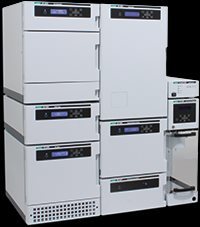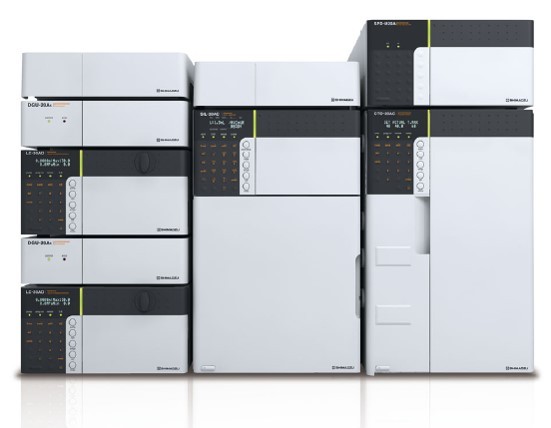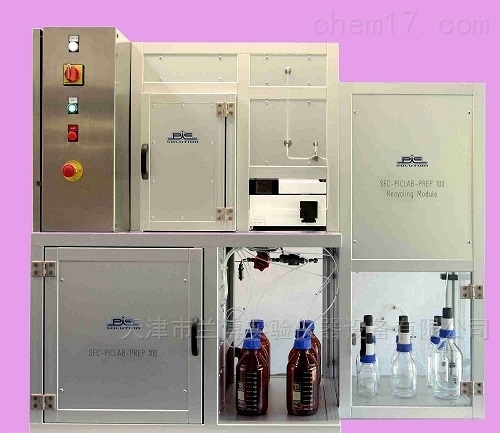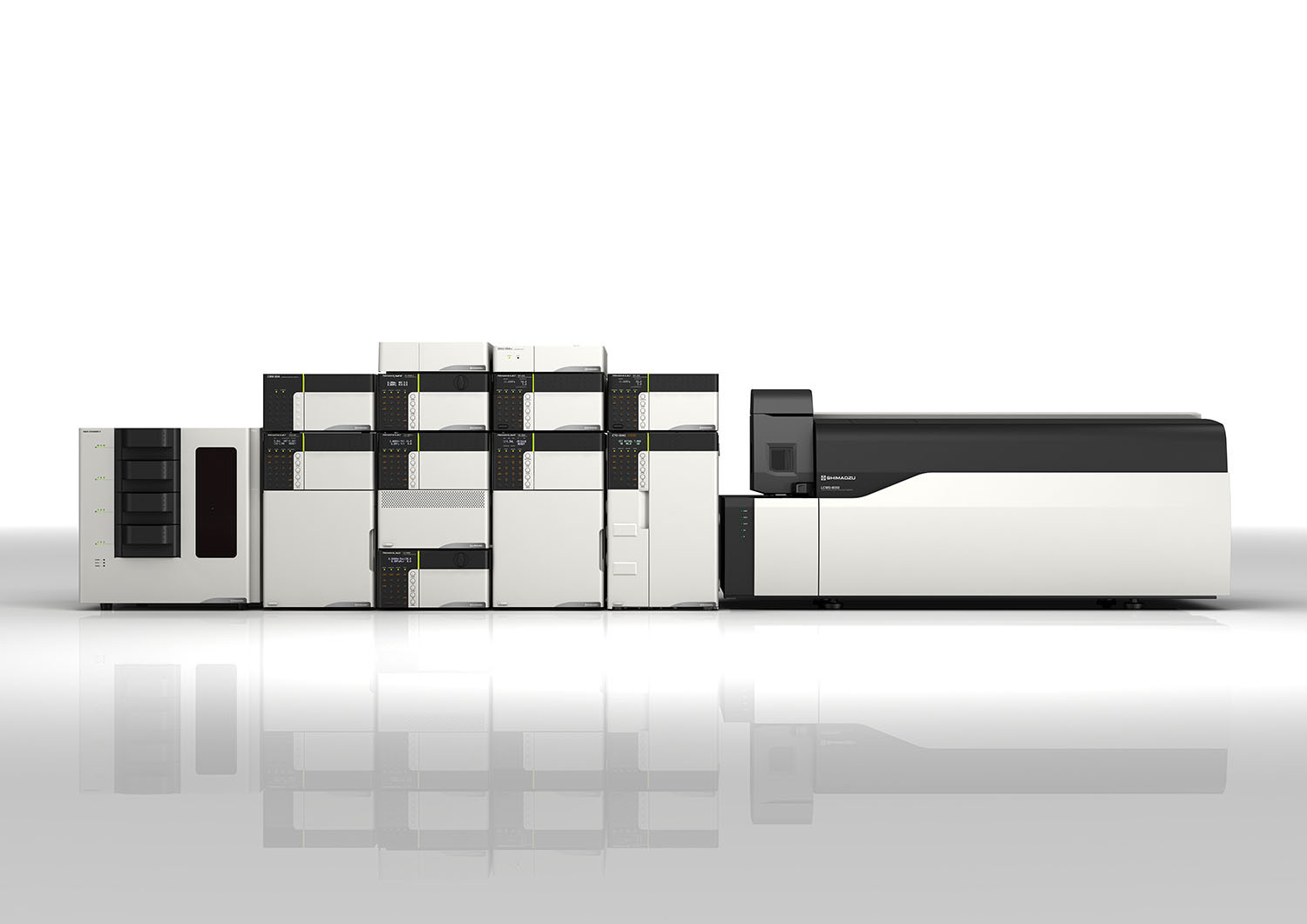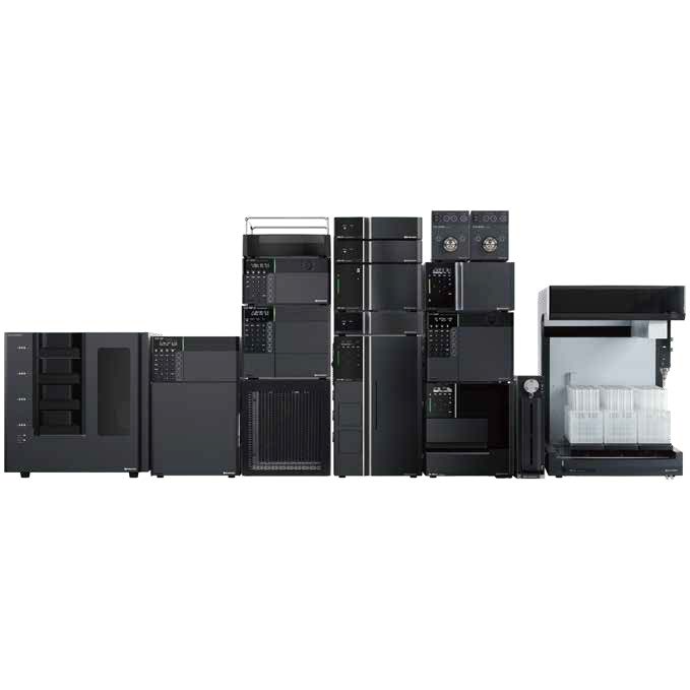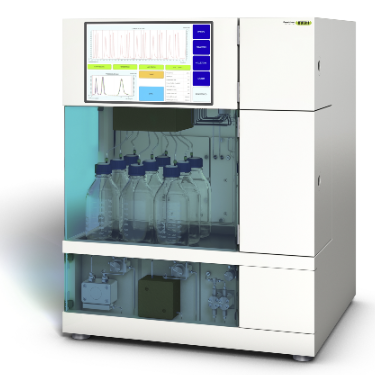方案详情
文
Introduction
Diesel fuel is a complex mixture of hydrocarbons including non-aromatic, mono-aromatic and polyaromatic hydrocarbons. It is well known that the composition of these compounds is closely related to the cetane number of fuel in the way that the cetane number becomes higher as the concentration of nonaromatics increases. The number becomes lower and the amount of particulate matter in exhaust gas increases as the concentration of aromatics increases. The analysis of diesel fuel is taking an important role in the automobile and fuel industries. ASTM (American Society for Testing and Materials) published the “Standard Test Method for Determination of the Aromatic Content and Polynuclear Aromatic Content of Diesel Fuels and Aviation Turbine Fuels By Supercritical Fluid Chromatography (D 5186 – 03)” using a Flame Ionization Detector (FID) in 2003 1). This application note demonstrates that SFC with supercritical CO2 can determine the non-aromatic and aromatic contents in commercially available diesel fuel in accordance with the ASTM method.
方案详情

SFC APPLICATION NOTE 01-10Contact:Jasco, Inc.28600 Mary's Court Easton,MD 21601Phone: 800-333-5272.Fax: 410-822-7526www.jascoinc.com Determination of Non-Aromatic andAromatic Hydrocarbon Contents ofDiesel Fuels by Supercritical FluidChromatography Diesel fuel is a complex mixture of hydrocarbonsincluding non-aromatic, momonnoo--aarroommatic and poly-aromatic hydrocarbons.It is well known that thecomposition of these compounds is closely related tothe cetane number of fuel in the way that the cetanenumber becomes higher as the concentration of non-aromatics increases. The number becomes lower andthe amount of particulate matter in exhaustgasincreases as the concentration of aromatics increases.The analysis of diesel fuel is taking an important rolein the automobile and fuel industries. ASTM (American Society ffoorr TestingeaandMaterials) published the “Standard Test Method forDetermination of theeAromaticContent andPolynuclear Aromatic Content of Diesel Fuels andAviation TurbineFuelsBySSupercriticallFluidChromatography (D 5186-- 03) using a FlameDetector (FID) in 2003 . This applicationnote demonstrates that SFC with supercritical CO2 candetermine the non-aromatic and aromatic contents incommercially available diesel fuel in accordance withthe ASTM method. Experimental The SFC system we used consisted of a JASCO modelPU-2080-CO2 Supercritical CO, delivery pump,aGC-4000 Gas chromatographwithaanFID (GLScience), JASCO's CO-2060 Column oven, a BP-2080automatic back-pressure regulator, and a JASCO AS-2059-SF autosampler with a Chromatography DataSystem controlling and data processing data from all ofabove modules. The SFCpak SIL PA column (5 umsilica gel, 4.6 mm I.D. x 250 mmL) was used for thesample separation. The column effluent was splitupstream of the back-pressure regulator and a certainamount of the fluid was introduced into the FID asshown in Figure 1. Figure 1 Schematic diagram of the supercritical chromatogram1 = bottle of liquefied carbon dioxide, 2= pump,3 =autosampler, 4=heatingcoil, 5=column, 6=column oven, 7= preheating coil, 8=splitter, 9= FID, 10= oven for GC, 11= cooling coil, 12=back-pressure regulator. Results and Discussion An SFC chromatogram of the standard mixture of 1-hexadecane (0.600 mg), toluene (0.0245 mg), tetralin(0.163 mg) and naphthalene (0.0163 mg) is shown inFigure 2. Excellent resolutions (Rs), 10.56 +/- 0.04 and6.27 +/-0.03 were obtained in the separation between 1-hexadecane andtolueneneaksandtetralinandnaphthaleneks rpeaks,resespectively. Also0excellentreproducibility of retention times (0.12 to 0.17% RSD,n=10) and peak areas (1.37 to 1.73% RSD, n=10) wereobtained as listed in Table 1. Figure 2 SFCchromatogram ofthe standard mixturePeaks: 1 = n-hexadecane (0.600 mg), 2 = toluene (0.0245 mg), 3 = tetralin(0.163 mg), 4= naphthalene (0.0163 mg)) Conditions: column = SFCpak SILPA (4.6 mm IDx250 mm L,5um), flow rate =2.0 mL/min, column temperature=35℃, temperature of FID = 350℃, back pressure= 20 MPa,injectionvolume=1 uL, GC oven temperature =200℃ Table 1 Reproducibility of retention time and peak area Analyte n-hexadecane toluene tetralin naphthalene average of retention time (min) 1.2240 2.0602 2.7068 3.3290 standard deviation (min) 0.0021 0.0027 0.0032 0.0043 relative standard deviation (%) 0.17 0.13 0.12 0.13 average of peak area (pV sec) 510673 149556 21701 14901 standard deviation (uV sec) 6983 2472 347 258 relative standard deviation(%) 137 1.65 1.60 1.73 We evaluated the linearity of peak response byinjecting 1uL each of standard mixtures with severaldifferent concentrations that were made up by diluting2, 3 and 4 times with n-hexadecane and observed goodlinearity. We injected 1 uL of commercially available diesel fuelinto the system and obtained the chromatogram whichis shown in Figure 3. Four repetitive injections of thefuell qcuantifiedtheecontents ofnon-aromatichydrocarbons to tbe (79.77±0.12%))and aromatichydrocarbons to be (20.23±0.12%). Figure 3 SFC chromatogram of diesel fuel Conditions: injection volume=1 uL. The other conditions are the same as inFigure 2. Nonaromatic and aromatic content is 79.77 and 20.23% (standarddeviation =0.12%) We have shown the JASCO SFC system1(can easilyperform the analysis requirements of the ASTM withprecision and accuracy. Reference 1) “Standard Test Method for Determination of theAromatic Content and Polynuclear Aromatic Content ofDiesel Fuels and Aviation7TurbineFuels BySupercritical Fluid Chromatography (D 5186-03)”
确定
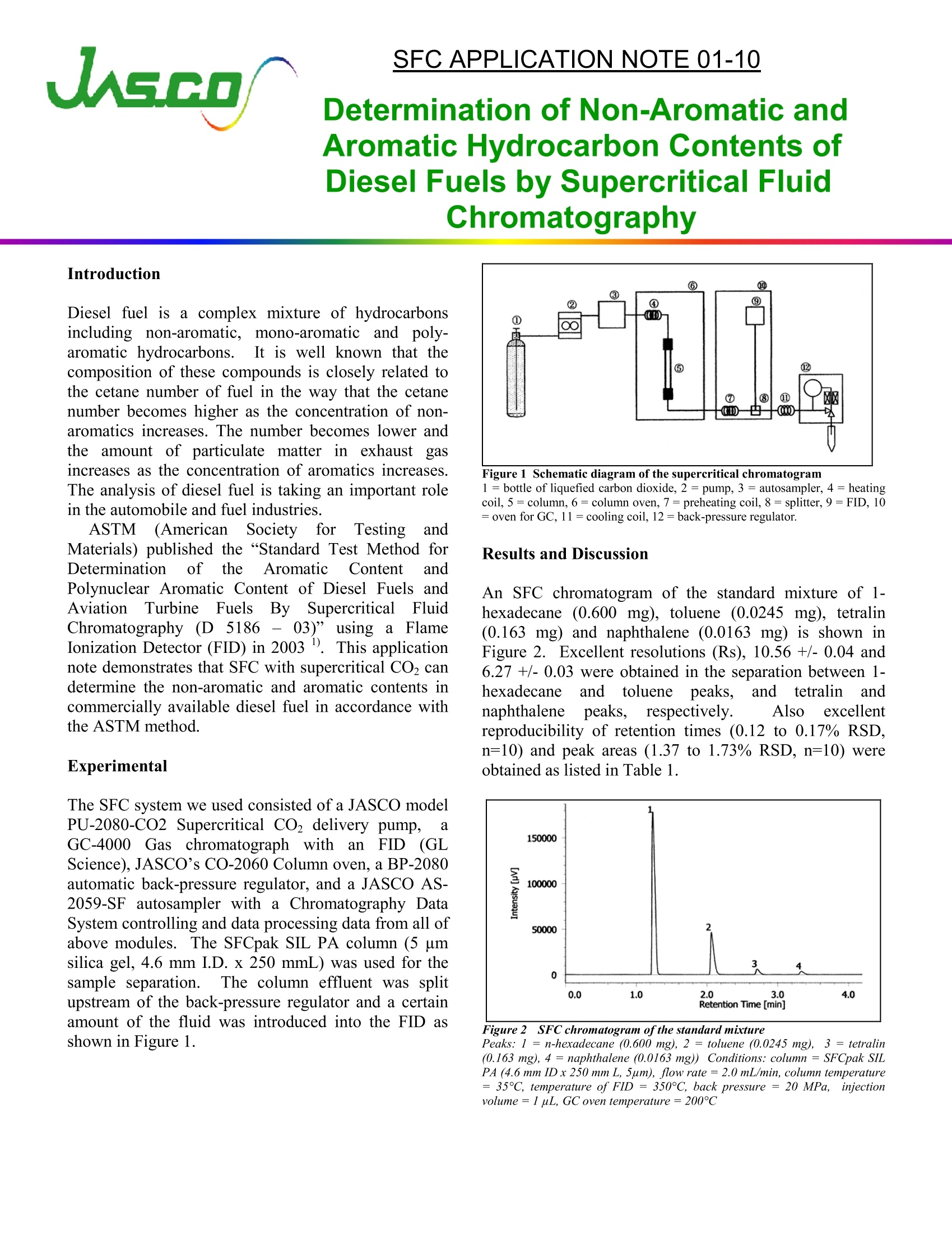
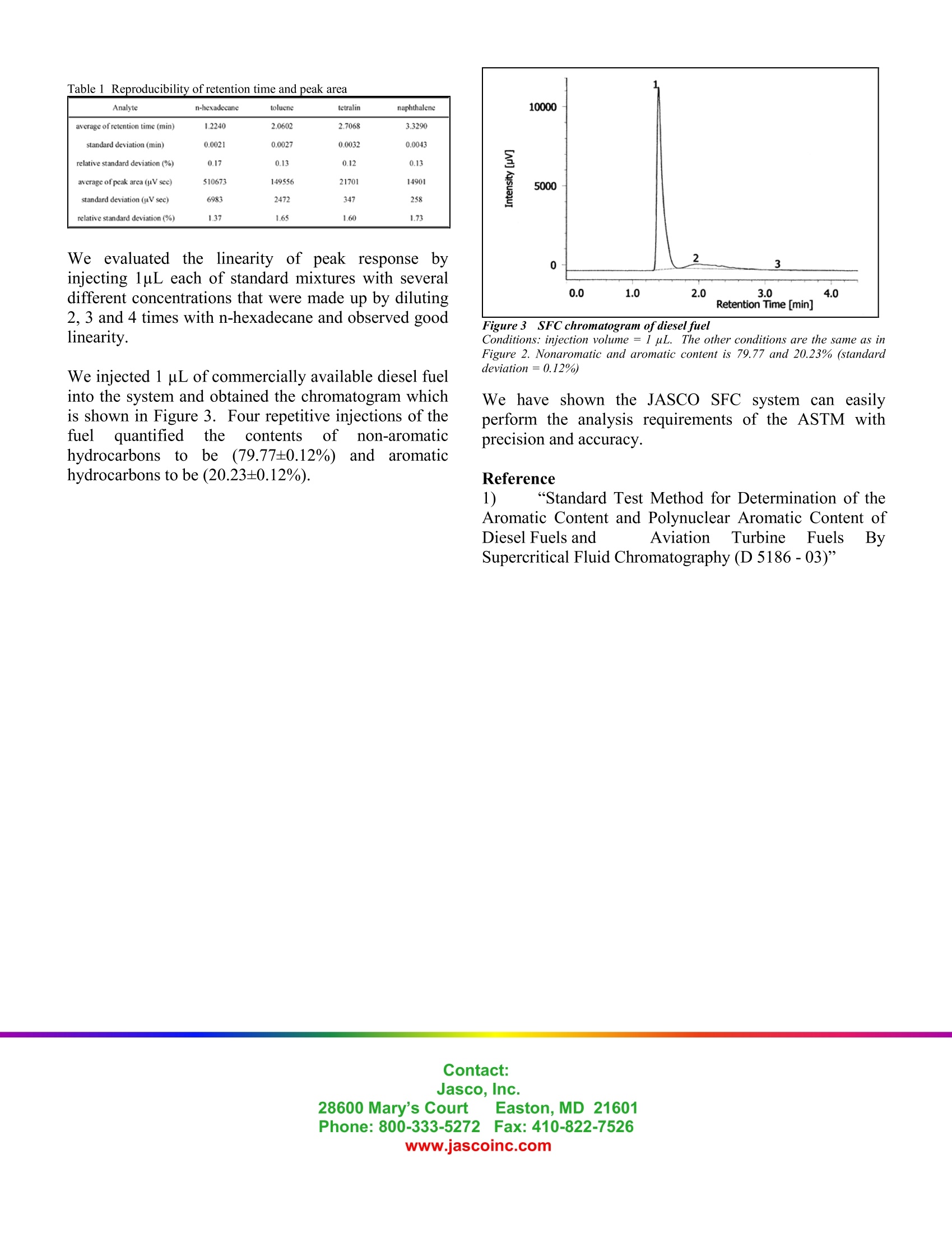
还剩1页未读,是否继续阅读?
佳士科商贸有限公司为您提供《柴油中非芳香族多硝基化合物和芳族烃检测方案 》,该方案主要用于汽油中非芳香族多硝基化合物和芳族烃检测,参考标准--,《柴油中非芳香族多硝基化合物和芳族烃检测方案 》用到的仪器有JASCO SFC4000超临界流体色谱仪
推荐专场
相关方案
更多
该厂商其他方案
更多

